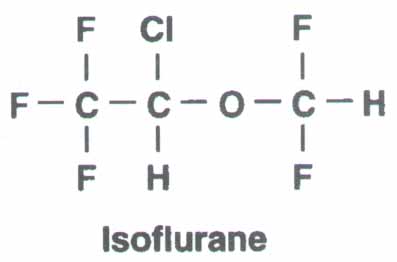Inhalational Anesthetic Agents
Isoflurane, CF3CHCl-O-CF2H

Introduced in 1981. The most commonly administered volatile anesthetic today.
Physical Properties
- vapor pressure = 240 mmHg at 20 deg C
- pungent ethereal odor
- chemical isomer of enflurane
Organ System Effects
Cardiovascular- minimal cardiac depression
- carotid baroreflexes relatively intact
- heart rate increases 10-20%
- mild beta-adrenergic stimulation
- dilates coronary arteries but
- several large studies failed to show convincing evidence of clinically significant coronary steal syndrome
- tachypnea, but less pronounced
- blunts hypoxic drive
- bronchodilator
- general anesthesia, MAC = 1.2
- > 1 MAC increases CBF and ICP
- hyperventilation reverses ICP increase
- decreases CMRO2
- flat EEG at 2 MAC
- hepatic O2 maintained better than with halothane or enflurane because
- hepatic artery perfusion and
- hepatic venous oxygen saturation are preserved
Biotransformation and Toxicity
- metabolized (principally to trifluoroacetic acid) only one-tenth as much as enflurane is
- up to 20 MAC-hours may lead to fluoride levels exceeding 50 micromol/L without detectable renal impairment
Contraindications
- malignant hyperthermia susceptibility
- severe hypovolemia